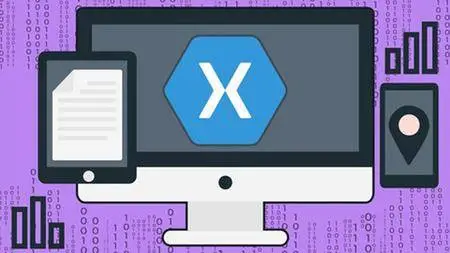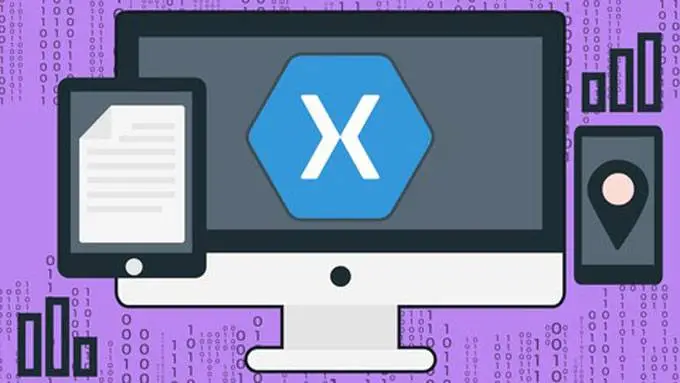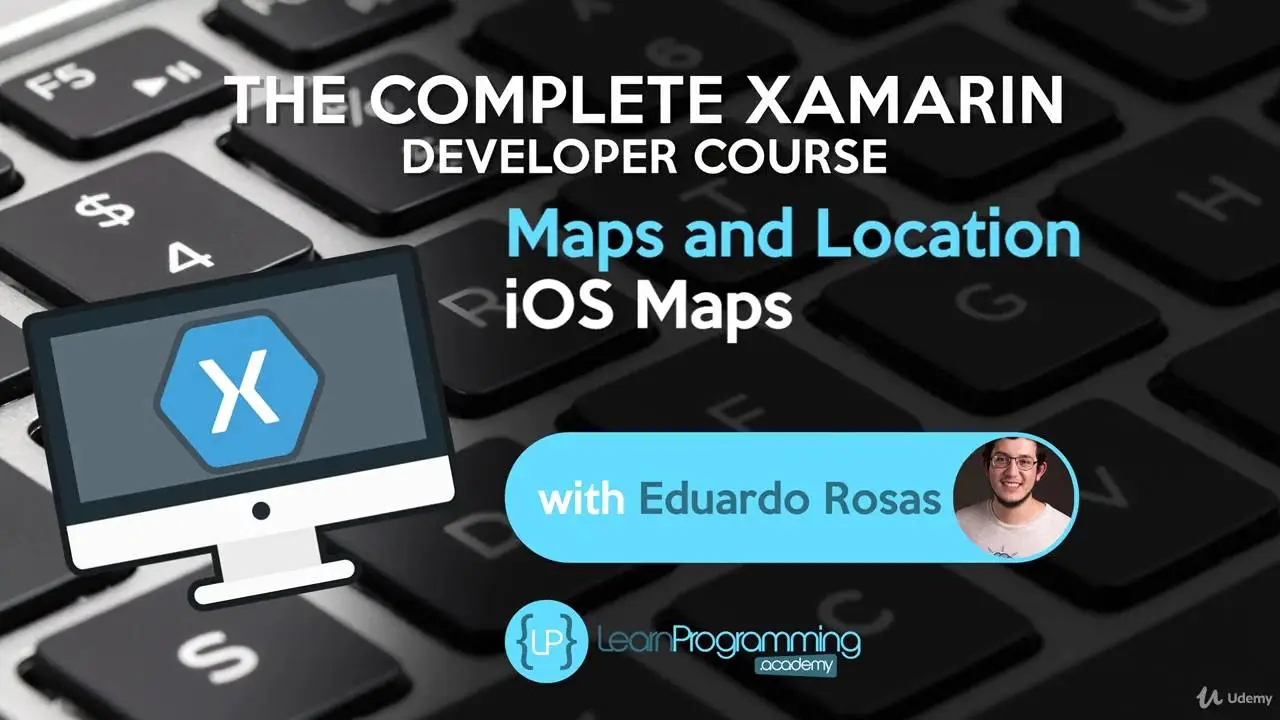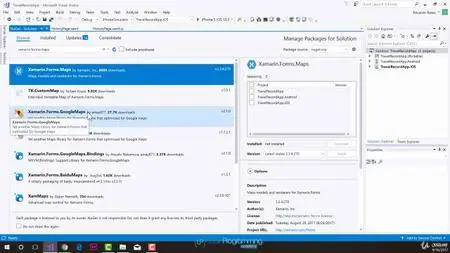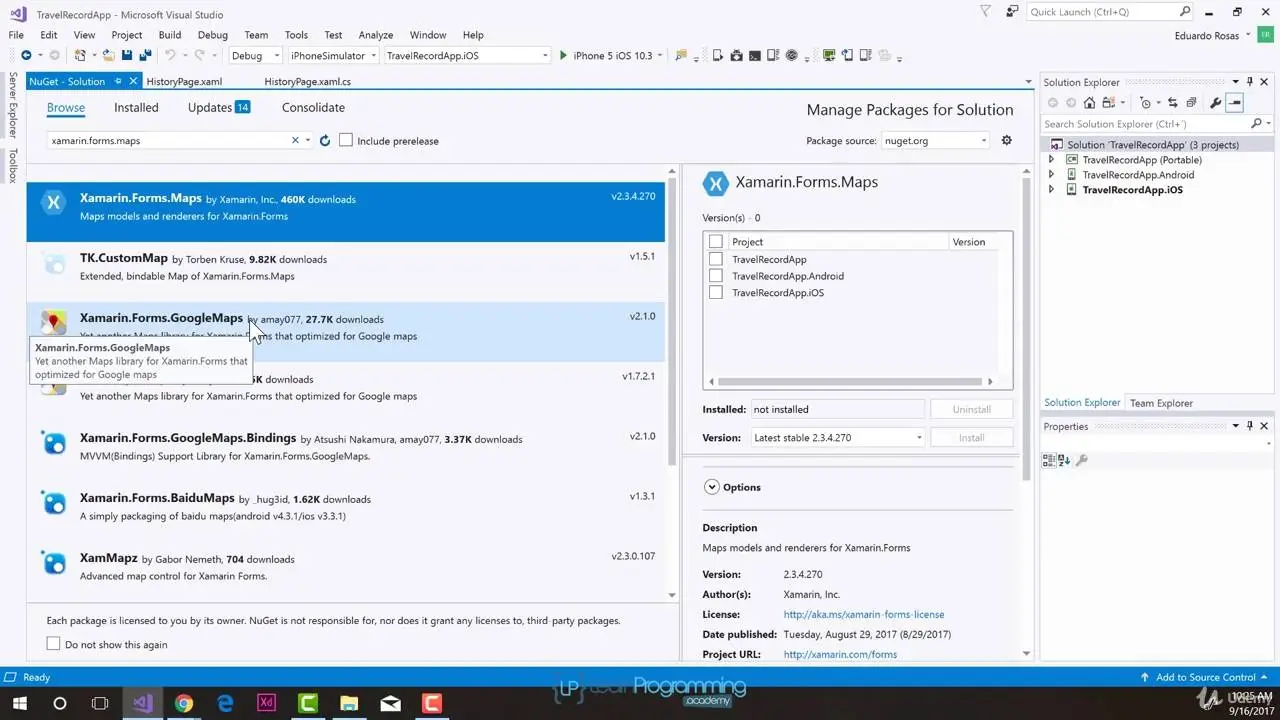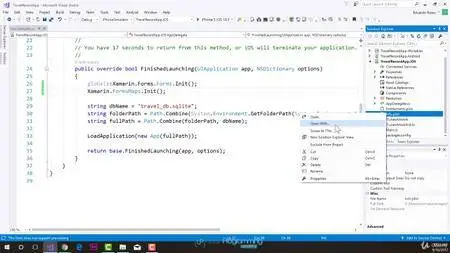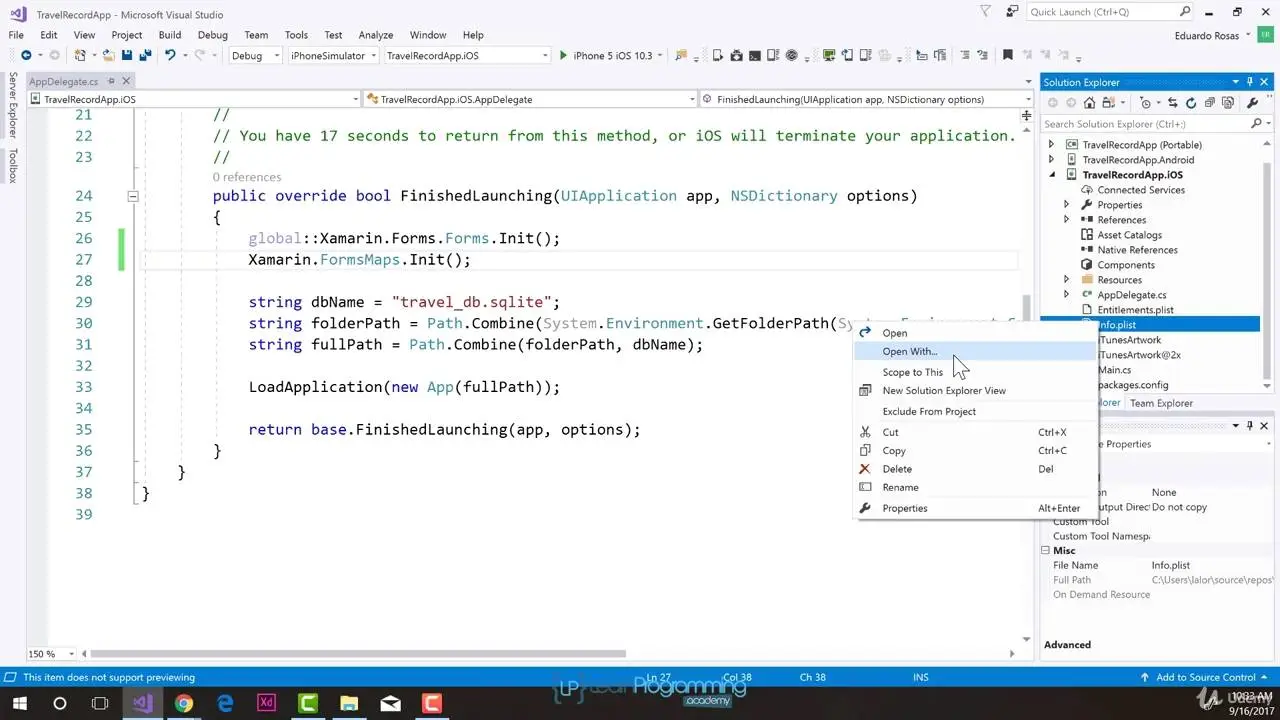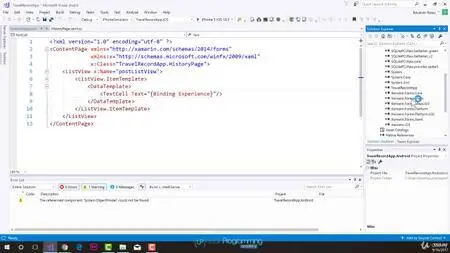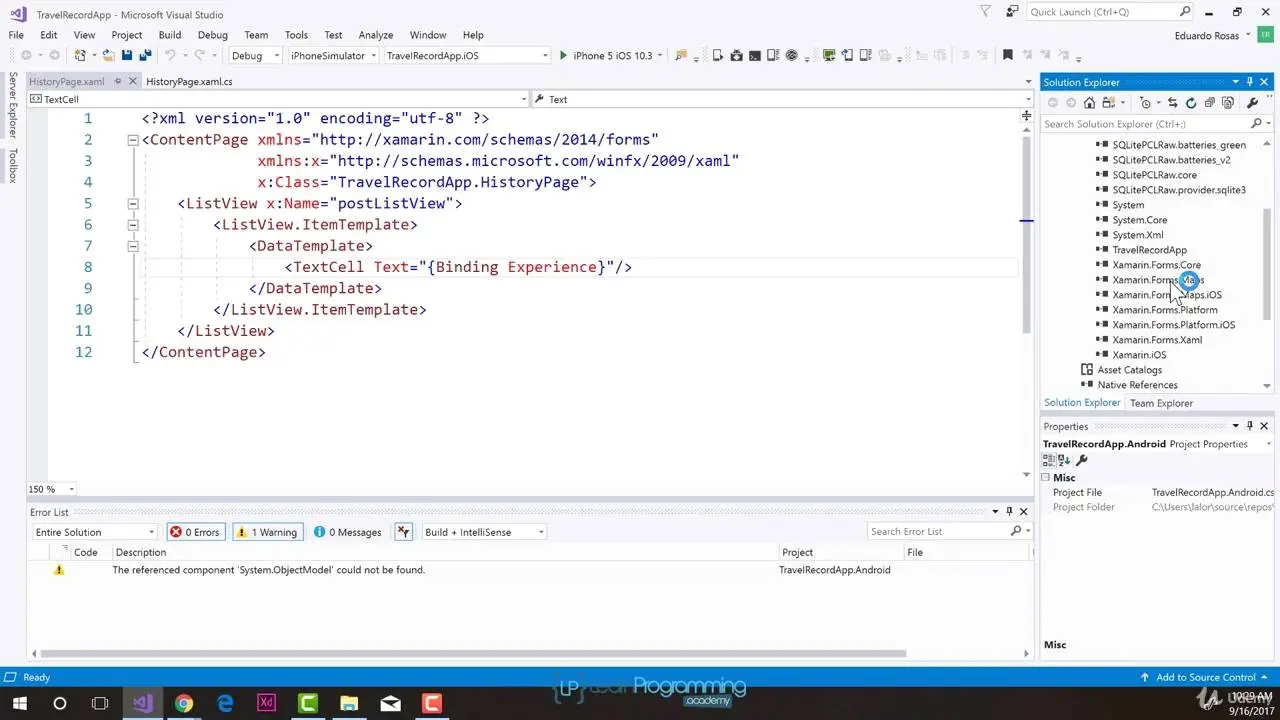The Complete Xamarin Developer Course: iOS And Android! (2018)
WEBRip | English | MP4 | 1280 x 720 | AVC ~686 kbps | 30 fps
AAC | 109 Kbps | 44.1 KHz | 2 channels | ~25 hours | Subs: English (.srt) | 3.51 GB
Genre: Video Tutorial
WEBRip | English | MP4 | 1280 x 720 | AVC ~686 kbps | 30 fps
AAC | 109 Kbps | 44.1 KHz | 2 channels | ~25 hours | Subs: English (.srt) | 3.51 GB
Genre: Video Tutorial
Build Cross Platform Android and iOS apps with Xamarin Forms, Xamarin Classic, Azure Mobile App Services, Rest and moreWhat will learn?
Create native Android and iOS apps that share up to 100% code
Apply for junior mobile development positions (Android and iOS)
Increased career options as a Multiplatform developer
Learning Xamarin opens up opportunities to build Windows Desktop, Windows Store, Mac, and even smart watch apps that share the logic of your iOS and Android app
So you've learnt some programming, but are struggling to get an interview, let alone a job.
Or you are stuck in a low paying programming job, and want to move up to a better, more senior position.
Maybe you have never programmed before, and are looking for a way to get into programming for the first time.
But, just how do you get employers to notice you? How do you make your resume stand out of the crowd of programmers looking for work?
By learning to create cross platform applications targeting both iOS and Android from the one codebase, using Xamarin.
What is Xamarin?
Xamarin is a Microsoft owned company, that allows developers, using a C#-shared codebase, to write native Android, iOS (and even Windows and MacOS) apps with native user interfaces and share code.
This means you can create an application once, and deploy it to both Android and iOS, both which run natively on the platform. One codebase, two platforms.
Learning to create apps with Xamarin makes you more valuable to your employer or clients as a result.
What does Xamarin mean to you?
You can create native Android and iOS apps that share up to 100% code! No more writing separate versions of apps for both platforms.
This is especially useful for indie developers or small teams who may not have had the resources to target both platforms. Now they can code once, and deploy to both platforms.
Ongoing maintenance costs are reduced because you have one code base! It also means by learning one language (C#) you can now write apps for both platforms.
The Microsoft Visual Studio software package is available on Windows and Mac, and both are shown in the course. You can use and deploy Xamarin whether you have a Windows machine or a Mac.
Xamarin creates native apps unlike most other cross platform tools, meaning the code you write and deploy from Xamarin is faster, and more efficient because it can target the inbuilt features of each platform.
Because Xamarin was recently purchased by Microsoft, you can be sure that it is getting the attention of small and large companies alike, meaning more opportunities are available for developers who have learnt and can use this technology to build apps (and you will learn to do that in this course).
Some of the key Xamarin things you will learn and be able to put to use in your own apps after going through this course include Xamarin Forms, Xamarin Classic, Using Azure Mobile App Services, Consuming REST services, Implementing SQLite databases and using the MVVM pattern (very important to learn and understand).
Why enrolling in this course is the best decision you can make.
Most other Xamarin courses only focus on Xamarin.Forms or Xamarin classic. BOTH are covered in this course. Also this course teaches you all about Azure Mobile App services (cloud database integration), which no other course teaches.
Your instructor, Eduardo Rosas, is a certified Xamarin Mobile Developer with 3 years of experience using the platform, and 5 years of experience using C#. He started developing apps for Windows Phone 7 back in 2012, which, just like Windows 8 and Windows 10, use C# and XAML, and uses those two languages for building Xamarin.Forms apps.
This means you are learning from someone who has all the professional training, skills, and experience you need to teach you how to become proficient in Xamarin the right way, as fast as possible.
If you are ready to get that first paid programming job, or to move up to a more senior programming position, then this course is for you!
After completing this course, you will have the necessary skills to be able to use Xamarin and create your own apps that target both iOS and Android.
The sooner you sign up for this course, the sooner you will have the skills and knowledge you need to increase your job or consulting opportunities. Xamarin skills are in high demand, as are Azure Mobile App services, and you will understand and be able to use both after going through this course.
Intro to Xamarin
21:01
What is Xamarin?
Preview
06:40
Why use Xamarin
Preview
05:26
Xamarin Classic vs Xamarin Forms
04:17
The Apps we'll build
04:38
–
Requirements and Preparing the Environment
28:36
Requirements
07:19
Installing Xcode on macOS
Preview
02:57
Installing Xamarin on macOS
05:01
Installing Xamarin on Windows
Preview
04:00
Setting the connection between Visual Studio and a Mac computer
Preview
04:18
Enabling the Xamarin Live Player on Windows
02:57
Enabling the Xamarin Live Player on Mac
02:04
–
Hello World with Xamarin.Forms
01:07:38
Shared Project vs Portable Class Libraries
Preview
04:45
Creating a Project on Windows
04:08
Creating a Project on Mac
02:20
The Structure of the Projects
04:49
Introduction to XAML
08:08
Coding the functionality of a button
06:32
Using the Xamarin Live Player
06:59
Debugging with Xamarin Live Player
Preview
04:28
Testing on an Android Simulator
04:42
Creating a new Android Emulator
05:56
Xamarin Device Manager
05:56
Testing on an iOS simulator
05:45
Remote iOS Simulator to Windows
03:10
–
XAML & Navigation - The travel record app
01:26:28
What is the .NET Standard
08:48
Creating the Login Page
08:54
Defining better Entry elements
04:16
The Xamarin Forms Previewer
04:31
Setting Margin in XAML
05:50
The Login Logic
Preview
09:51
Navigation Page
12:42
Tabbed Page
08:33
Toolbar Item
06:16
XAML Resources
08:00
Implicit XAML Styles
05:30
Explicit XAML Styles
Preview
03:17
–
C# Fundamentals
01:38:47
Creating a Console App
05:06
Methods
07:46
Variables and Scope
05:06
Methods and Variables Challenge
05:52
Classes and Namespaces
12:55
Objects - Instances of a Class
12:00
Properties
06:48
Overloading Methods
Preview
04:59
Inheritance
09:03
Method Overriding
06:53
Interfaces
05:20
Implementing an Interface
07:09
Asynchronous Programming
09:50
–
SQLite - Local Databases
59:46
Adding SQLite
Preview
04:44
New App Constructor
04:12
Database Paths
06:39
The Model of a Database Table
03:45
SQLite Atributes
02:53
Inserting into the Database
11:31
Read from the Database
09:15
The IDisposable interface and Using statements
04:28
Data Binding
04:35
ListView
07:44
–
Maps and Location
38:06
Getting iOS Project ready for Maps
Preview
07:53
Getting Android Project ready for Maps
08:38
Displaying Maps from XAML
05:40
Displaying the User's Location
03:25
Handling Location Changes
12:30
–
REST - Consuming Foursquare Services
01:22:37
Exploring the Foursquare API
12:50
Creating URL for REST Request
08:23
Preparing Projects
Preview
03:30
Making HTTP Get Requests
11:18
Venue model from JSON
06:40
Deserializing Json strings into C# objects
06:21
Custom Cells
10:26
Updating the Post Model
12:12
Displaying pins on a map
10:57
–
Working with Images
29:58
Displaying shared images
09:58
Android Images
07:11
iOS Images
07:02
Displaying Platform Specific Images
05:47
–
Linq
27:31
Profile Page
07:05
Linq Distinct - Unique values from a list
Preview
07:03
Linq Where - Filtering a list
04:39
ListViews and Dictionaries
08:44
-
Azure Services
01:09:51
Azure App Service
03:35
Azure Subscription
03:32
Creating the App Service
05:40
Easy Tables
04:42
Connecting to the App Service
06:29
The Register Page
06:59
Inserting into a Cloud Database
07:22
Reading from a Cloud database
10:24
Inserting with Foreign Key
09:29
Reading Filtered Data
06:42
Multiple Devices
04:57
-
MVVM
03:41:52
Introduction to MVVM
04:55
The Model
04:38
Challenge - Improving the Model
10:45
The View Model
03:56
The INotify Property Changed interface
04:32
Implementing the INotyfyPropertyChanged
06:28
Binding Context
09:50
The ICommand Interface
03:16
Implementing ICommand
05:03
Binding Commands
05:39
Command Parameters
17:34
Replacing Events Challenge - Part 1
19:39
Replacing Events Challenge - Part 2
18:27
The IValueConverter
04:06
Implementing the IValueConverter
15:02
The ObservableCollection<T> class
03:38
Using the ObservableCollection<T>
07:02
Xamarin Forms Wrap Up
02:56
Using Fast Renderers
06:03
Using LayoutCompression
05:32
Permissions
12:49
ListView Interactivity
14:32
Preparing Offline Database Sync
12:26
Performing Offline Database Sync
14:33
Implementing and Testing Offline Sync
08:31
-
Storing Images in the Cloud
32:17
Selecting an Image
15:53
Creating an Azure Storage Service
03:56
Preparing the Project
02:13
Uploading an Image
10:15
-
Hello World - Xamarin Native
49:10
Xamarin Forms vs Xamarin Classic
03:48
Creating a Native project - Windows
04:28
Creating a Native project - Mac
04:11
The AXML Designer for Android
05:35
The AXML Source code
04:44
Android Activity
09:44
The iOS Storyboard
06:54
The ViewController
09:46
-
The Delivery App Login - Android
27:09
The Apps we'll build
03:30
The Login Page
06:27
Creating a new Activity
06:13
Intents
05:13
Passing Values through Intents
05:46
-
The Delivery App Login - iOS
34:10
The Login Page
04:29
Adding Constraints
08:51
New ViewController
06:59
The NavigationController
06:17
Segues
07:34
-
Azure App Services on Xamarin classic apps
41:00
Creating another Azure App Service
06:10
Connecting to the App Service
06:04
Creating a Table and its Class
04:15
Inserting into a Table
12:37
Reading from a Table
11:54
-
Sharing code
47:49
The PCL
04:50
Reusing Login Functionality
12:35
Reuisng Register Functionality
09:02
Read Tables
06:40
Intro to Generics
05:46
Inserting to any Table
08:56
-
Tabs in Android
01:01:43
Preparing Android Project to use Tab Layout
10:01
Using the TabLayout
06:30
Navigating between Fragments
17:34
Prevent Back Navigation
03:12
Toolbar Navigation
16:30
Inserting Deliveries
07:56
-
Tabs in iOS
36:07
The TabBarController
09:57
Adding One View Per Tab
10:54
Prevent Back Navigation
04:48
The BarButtonItem
10:28
-
Lists in Android
33:28
The ListFragment
03:46
The ListAdapter
11:36
Using a Custom Adapter
18:06
-
Lists in iOS
33:29
The TableViewController
04:50
The TableViewCell
15:23
Using a Custom Cell
13:16
-
Maps in Android
46:29
Preparing the Project to use Maps
10:44
Obtaining the Google Maps API Key
03:46
Displaying Maps (Android)
05:57
Location and Pins
11:37
Running on Android Device
14:25
-
Maps in iOS
21:33
Displaying Maps (iOS)
07:56
Location and Pins in iOS
10:08
Getting the Center of the Map
03:29
-
The Delivery Person's App
01:56:15
The Layout for the new App
09:39
UI And Navigation Challenge - Part 1
19:34
UI And Navigation Challenge - Part 2
05:02
UI And Navigation Challenge - Part 3
11:03
Updating Deliveries
09:09
Implemeiting Functionality Challenge - Part 1
21:54
Implemeiting Functionality Challenge - Part 2
19:39
DisplayingMaps and Getting Directions
20:15
-
Adding Platform Specific Functionality
01:15:45
Biometric Authentication - iOS
14:16
Biometric Authentication - Android
19:49
Haptic Feedback
08:05
App Shortcuts
19:39
Updating Android Projects to Oreo
07:43
Updating iOS Project to iOS 11
06:13
-
Publishing to the App Stores
52:30
Preparing the Android Project
13:21
Generating APK
03:48
Publishing your Android Application
06:39
Preparing the iOS Project
07:22
Generating IPA
14:06
Publishing your iOS Application
07:14
-
Bonus Material
11:53
Bonus - Please Watch!
00:48
21:01
What is Xamarin?
Preview
06:40
Why use Xamarin
Preview
05:26
Xamarin Classic vs Xamarin Forms
04:17
The Apps we'll build
04:38
–
Requirements and Preparing the Environment
28:36
Requirements
07:19
Installing Xcode on macOS
Preview
02:57
Installing Xamarin on macOS
05:01
Installing Xamarin on Windows
Preview
04:00
Setting the connection between Visual Studio and a Mac computer
Preview
04:18
Enabling the Xamarin Live Player on Windows
02:57
Enabling the Xamarin Live Player on Mac
02:04
–
Hello World with Xamarin.Forms
01:07:38
Shared Project vs Portable Class Libraries
Preview
04:45
Creating a Project on Windows
04:08
Creating a Project on Mac
02:20
The Structure of the Projects
04:49
Introduction to XAML
08:08
Coding the functionality of a button
06:32
Using the Xamarin Live Player
06:59
Debugging with Xamarin Live Player
Preview
04:28
Testing on an Android Simulator
04:42
Creating a new Android Emulator
05:56
Xamarin Device Manager
05:56
Testing on an iOS simulator
05:45
Remote iOS Simulator to Windows
03:10
–
XAML & Navigation - The travel record app
01:26:28
What is the .NET Standard
08:48
Creating the Login Page
08:54
Defining better Entry elements
04:16
The Xamarin Forms Previewer
04:31
Setting Margin in XAML
05:50
The Login Logic
Preview
09:51
Navigation Page
12:42
Tabbed Page
08:33
Toolbar Item
06:16
XAML Resources
08:00
Implicit XAML Styles
05:30
Explicit XAML Styles
Preview
03:17
–
C# Fundamentals
01:38:47
Creating a Console App
05:06
Methods
07:46
Variables and Scope
05:06
Methods and Variables Challenge
05:52
Classes and Namespaces
12:55
Objects - Instances of a Class
12:00
Properties
06:48
Overloading Methods
Preview
04:59
Inheritance
09:03
Method Overriding
06:53
Interfaces
05:20
Implementing an Interface
07:09
Asynchronous Programming
09:50
–
SQLite - Local Databases
59:46
Adding SQLite
Preview
04:44
New App Constructor
04:12
Database Paths
06:39
The Model of a Database Table
03:45
SQLite Atributes
02:53
Inserting into the Database
11:31
Read from the Database
09:15
The IDisposable interface and Using statements
04:28
Data Binding
04:35
ListView
07:44
–
Maps and Location
38:06
Getting iOS Project ready for Maps
Preview
07:53
Getting Android Project ready for Maps
08:38
Displaying Maps from XAML
05:40
Displaying the User's Location
03:25
Handling Location Changes
12:30
–
REST - Consuming Foursquare Services
01:22:37
Exploring the Foursquare API
12:50
Creating URL for REST Request
08:23
Preparing Projects
Preview
03:30
Making HTTP Get Requests
11:18
Venue model from JSON
06:40
Deserializing Json strings into C# objects
06:21
Custom Cells
10:26
Updating the Post Model
12:12
Displaying pins on a map
10:57
–
Working with Images
29:58
Displaying shared images
09:58
Android Images
07:11
iOS Images
07:02
Displaying Platform Specific Images
05:47
–
Linq
27:31
Profile Page
07:05
Linq Distinct - Unique values from a list
Preview
07:03
Linq Where - Filtering a list
04:39
ListViews and Dictionaries
08:44
-
Azure Services
01:09:51
Azure App Service
03:35
Azure Subscription
03:32
Creating the App Service
05:40
Easy Tables
04:42
Connecting to the App Service
06:29
The Register Page
06:59
Inserting into a Cloud Database
07:22
Reading from a Cloud database
10:24
Inserting with Foreign Key
09:29
Reading Filtered Data
06:42
Multiple Devices
04:57
-
MVVM
03:41:52
Introduction to MVVM
04:55
The Model
04:38
Challenge - Improving the Model
10:45
The View Model
03:56
The INotify Property Changed interface
04:32
Implementing the INotyfyPropertyChanged
06:28
Binding Context
09:50
The ICommand Interface
03:16
Implementing ICommand
05:03
Binding Commands
05:39
Command Parameters
17:34
Replacing Events Challenge - Part 1
19:39
Replacing Events Challenge - Part 2
18:27
The IValueConverter
04:06
Implementing the IValueConverter
15:02
The ObservableCollection<T> class
03:38
Using the ObservableCollection<T>
07:02
Xamarin Forms Wrap Up
02:56
Using Fast Renderers
06:03
Using LayoutCompression
05:32
Permissions
12:49
ListView Interactivity
14:32
Preparing Offline Database Sync
12:26
Performing Offline Database Sync
14:33
Implementing and Testing Offline Sync
08:31
-
Storing Images in the Cloud
32:17
Selecting an Image
15:53
Creating an Azure Storage Service
03:56
Preparing the Project
02:13
Uploading an Image
10:15
-
Hello World - Xamarin Native
49:10
Xamarin Forms vs Xamarin Classic
03:48
Creating a Native project - Windows
04:28
Creating a Native project - Mac
04:11
The AXML Designer for Android
05:35
The AXML Source code
04:44
Android Activity
09:44
The iOS Storyboard
06:54
The ViewController
09:46
-
The Delivery App Login - Android
27:09
The Apps we'll build
03:30
The Login Page
06:27
Creating a new Activity
06:13
Intents
05:13
Passing Values through Intents
05:46
-
The Delivery App Login - iOS
34:10
The Login Page
04:29
Adding Constraints
08:51
New ViewController
06:59
The NavigationController
06:17
Segues
07:34
-
Azure App Services on Xamarin classic apps
41:00
Creating another Azure App Service
06:10
Connecting to the App Service
06:04
Creating a Table and its Class
04:15
Inserting into a Table
12:37
Reading from a Table
11:54
-
Sharing code
47:49
The PCL
04:50
Reusing Login Functionality
12:35
Reuisng Register Functionality
09:02
Read Tables
06:40
Intro to Generics
05:46
Inserting to any Table
08:56
-
Tabs in Android
01:01:43
Preparing Android Project to use Tab Layout
10:01
Using the TabLayout
06:30
Navigating between Fragments
17:34
Prevent Back Navigation
03:12
Toolbar Navigation
16:30
Inserting Deliveries
07:56
-
Tabs in iOS
36:07
The TabBarController
09:57
Adding One View Per Tab
10:54
Prevent Back Navigation
04:48
The BarButtonItem
10:28
-
Lists in Android
33:28
The ListFragment
03:46
The ListAdapter
11:36
Using a Custom Adapter
18:06
-
Lists in iOS
33:29
The TableViewController
04:50
The TableViewCell
15:23
Using a Custom Cell
13:16
-
Maps in Android
46:29
Preparing the Project to use Maps
10:44
Obtaining the Google Maps API Key
03:46
Displaying Maps (Android)
05:57
Location and Pins
11:37
Running on Android Device
14:25
-
Maps in iOS
21:33
Displaying Maps (iOS)
07:56
Location and Pins in iOS
10:08
Getting the Center of the Map
03:29
-
The Delivery Person's App
01:56:15
The Layout for the new App
09:39
UI And Navigation Challenge - Part 1
19:34
UI And Navigation Challenge - Part 2
05:02
UI And Navigation Challenge - Part 3
11:03
Updating Deliveries
09:09
Implemeiting Functionality Challenge - Part 1
21:54
Implemeiting Functionality Challenge - Part 2
19:39
DisplayingMaps and Getting Directions
20:15
-
Adding Platform Specific Functionality
01:15:45
Biometric Authentication - iOS
14:16
Biometric Authentication - Android
19:49
Haptic Feedback
08:05
App Shortcuts
19:39
Updating Android Projects to Oreo
07:43
Updating iOS Project to iOS 11
06:13
-
Publishing to the App Stores
52:30
Preparing the Android Project
13:21
Generating APK
03:48
Publishing your Android Application
06:39
Preparing the iOS Project
07:22
Generating IPA
14:06
Publishing your iOS Application
07:14
-
Bonus Material
11:53
Bonus - Please Watch!
00:48
also You can watch my other last: Programming-posts
Screenshots
Exclusive eLearning Videos ParRus-blog ← add to bookmarks


